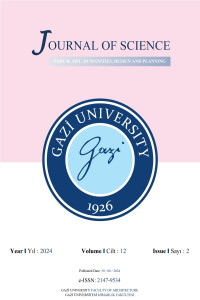Abstract
References
- [1] Sunar, L. (2018). “Social Change: A Theoretical and Conceptual Framework”, Social Change Theories, Anadolu University Publication No: 3563, pp.3-8, Eskişehir, Ed: Mustafa Altunoğlu.
- [2] Lowe, R. (1997). Schooling and Social Change, 1964- 1990. London: New York: Routledge.
- [3] Zencirkıran, M. (2019). “Education in Turkey”, Turkey's Social Structure, Anadolu University Publication No: 3954, pp.133, Eskişehir.
- [4] Franck, O.A. (2015). Politics and architecture: Ernst Egli and the search for modernity in Turkey (1927-1940), Ed. N.Müge Cengizkan , TMMOB Chamber of Architects.
- [5] Bozkurt, B. (2021, 12 February). John Dewey (1859-1952). Atatürk Encyclopedia. URL- 1. https://ataturkansiklopedisi.gov.tr/bilgi/john-dewey-1859-1952/ Last Accessed: 06.01.2022.
- [6] Alpagut, L. (2009). An architect in the 1930s: İzzet Baysal. Hacettepe University Faculty of Letters Journal, (26)1.
- [7] Aslanoğlu, İ. N., (1980). 1923-1930 Early Republican Period Architecture: Social, Economic, Cultural Environment Change and Its Reflection on Architecture. İTÜ Faculty of Architecture. (Doctoral dissertation, İTÜ).
- [8] Sözen, M. (1984). Turkish architecture of the Republican period, 1923-1983. Türkiye İş Bankası Cultural Publications.
- [9] Batur, A. (1998). “Turkish Architecture in the Period of 1925-1950”, 75 years of urban and Architectural Change, İstanbul: History Foundation Publications, pp.209-234. Ed: Yıldız Sey.
- [10] Bozdoğan, S. (2001). Modernism and Nation Building: Turkish Architectural Culture in The Early Republic.
Investigation of the Rectorate Buildings in Ankara built before 1950 as an Example of National Architecture
Abstract
In the early years of the Republic, the changes(transformation) in Turkey also affected the education system, and a "national" educational mobilization was initiated. With the influence of the economic conditions of the period, the construction of important and compulsory public buildings such as "health and education buildings" was prioritized. This study aims to examine the relationship between the campuses where the service buildings of Gazi University Rectorate, Ankara Medipol University Rectorate and Ankara Social Sciences University Rectorate are located and the architectural composition of the rectorate buildings as an example of national architecture. It was observed that the Rectorate buildings of Ankara Medipol University and Ankara Social Sciences University had different functions before and were re-functionalized and used as rectorate service buildings today. It is possible to say that the examined examples are designed in a similar architectural style, registered as cultural assets requiring protection, located in the city center, and that holistic design is important in the green area/development ratios of the campuses and the relations they establish with their surroundings. In this context, it is thought that this study is important in terms of emphasizing the place of rectorate buildings in the social framework and their importance in the history of Turkish education and will contribute to the research and literature on this subject
Keywords
National Architecture Architect Kemaleddin Bey Gazi University Rectorate Building Ankara Social Sciences University Rectorate Building Medipol University Rectorate Building
References
- [1] Sunar, L. (2018). “Social Change: A Theoretical and Conceptual Framework”, Social Change Theories, Anadolu University Publication No: 3563, pp.3-8, Eskişehir, Ed: Mustafa Altunoğlu.
- [2] Lowe, R. (1997). Schooling and Social Change, 1964- 1990. London: New York: Routledge.
- [3] Zencirkıran, M. (2019). “Education in Turkey”, Turkey's Social Structure, Anadolu University Publication No: 3954, pp.133, Eskişehir.
- [4] Franck, O.A. (2015). Politics and architecture: Ernst Egli and the search for modernity in Turkey (1927-1940), Ed. N.Müge Cengizkan , TMMOB Chamber of Architects.
- [5] Bozkurt, B. (2021, 12 February). John Dewey (1859-1952). Atatürk Encyclopedia. URL- 1. https://ataturkansiklopedisi.gov.tr/bilgi/john-dewey-1859-1952/ Last Accessed: 06.01.2022.
- [6] Alpagut, L. (2009). An architect in the 1930s: İzzet Baysal. Hacettepe University Faculty of Letters Journal, (26)1.
- [7] Aslanoğlu, İ. N., (1980). 1923-1930 Early Republican Period Architecture: Social, Economic, Cultural Environment Change and Its Reflection on Architecture. İTÜ Faculty of Architecture. (Doctoral dissertation, İTÜ).
- [8] Sözen, M. (1984). Turkish architecture of the Republican period, 1923-1983. Türkiye İş Bankası Cultural Publications.
- [9] Batur, A. (1998). “Turkish Architecture in the Period of 1925-1950”, 75 years of urban and Architectural Change, İstanbul: History Foundation Publications, pp.209-234. Ed: Yıldız Sey.
- [10] Bozdoğan, S. (2001). Modernism and Nation Building: Turkish Architectural Culture in The Early Republic.
Details
| Primary Language | English |
|---|---|
| Subjects | Architectural Heritage and Conservation |
| Journal Section | Architecture |
| Authors | |
| Publication Date | June 30, 2024 |
| Submission Date | April 1, 2024 |
| Acceptance Date | May 14, 2024 |
| Published in Issue | Year 2024 Volume: 12 Issue: 2 |


